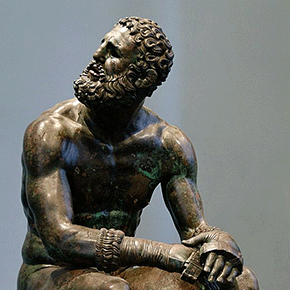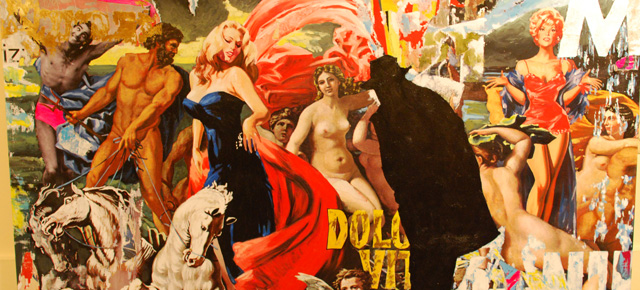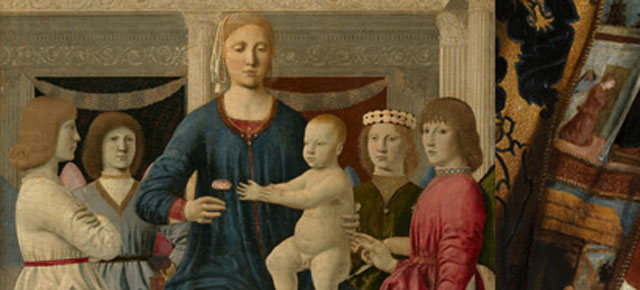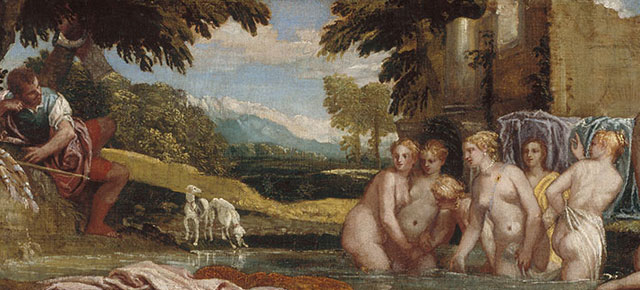
The first comprehensive overview of Italian Futurism to be presented in the United States, this multidisciplinary exhibition examines the historical sweep of the movement from its inception with F. T. Marinetti’s Futurist manifesto in 1909 through its demise at the end of World War II. Presenting over 300 works executed between 1909 and 1944, the chronological exhibition encompasses not only painting and sculpture, but also architecture, design, ceramics, fashion, film, photography, advertising, free-form poetry, publications, music, theater, and performance. To convey the myriad artistic languages employed by the Futurists as they evolved over a 35-year period, the exhibition integrates multiple disciplines in each section. Italian Futurism is organized by Vivien Greene, Curator, 19th- and Early 20th-Century Art, Solomon R. Guggenheim Museum. In addition, a distinguished international advisory committee has been assembled to provide expertise and guidance.
Giacomo Balla, Abstract Speed + Sound (Velocità astratta + rumore), 1913–14. Oil on board, 54.5 x 76.5 cm. The Solomon R. Guggenheim Foundation, Peggy Guggenheim Collection, Venice. © 2012 Artists Rights Society (ARS), New York/SIAE, Rome
Leonardo da Vinci created masterpieces of art and sculpture. Equally remarkable, his aggregate achievements in engineering, mathematics, anatomy, geology, physics, music, military technology, aeronautics, and a wide range of other fields, not only stood without peer in his own time, but were strikingly prescient for the distant future. He recorded his forward-looking ideas in thousands of notebook pages, known as codices. He produced one codex entirely on flight in 1505-1506, the Codex on the Flight of Birds. Among the many subjects Leonardo studied, the possibility of human mechanical flight held particular fascination. He produced more than 35,000
 words and 500 sketches dealing with flying machines, the nature of air, and bird flight. In the Codex on the Flight of Birds Leonardo outlined a number of observations and beginning concepts that would find a place in the development of a successful airplane in the early twentieth century. Hundreds of years before any real progress toward a practical flying machine was achieved, Leonardo expressed the seeds of the ideas that would lead to humans spreading their wings. This extraordinary document, exhibited outside of Italy only a few times, will be displayed in The Wright Brothers & The Invention of the Aerial Age gallery. The Codex exhibit will be a once-in-a-lifetime opportunity to appreciate the genius of da Vinci in the same space as the Wright Flyer, which made the airplane a reality four centuries after the Leonardo produced the Codex on the Flight of Birds.
words and 500 sketches dealing with flying machines, the nature of air, and bird flight. In the Codex on the Flight of Birds Leonardo outlined a number of observations and beginning concepts that would find a place in the development of a successful airplane in the early twentieth century. Hundreds of years before any real progress toward a practical flying machine was achieved, Leonardo expressed the seeds of the ideas that would lead to humans spreading their wings. This extraordinary document, exhibited outside of Italy only a few times, will be displayed in The Wright Brothers & The Invention of the Aerial Age gallery. The Codex exhibit will be a once-in-a-lifetime opportunity to appreciate the genius of da Vinci in the same space as the Wright Flyer, which made the airplane a reality four centuries after the Leonardo produced the Codex on the Flight of Birds.
This exhibit is organized by the Smithsonian National Air and Space Museum and the Italian Ministry of Foreign Affairs, the Ministry of Italian Cultural Heritage and Activities, the Embassy of Italy in Washington, DC, the Biblioteca Reale in Turin, thanks to the support of Bracco Foundation, Finmeccanica, and Tenaris. It is part of 2013 – Year of Italian Culture in the U.S., an initiative held under the auspices of the President of the Italian Republic, organized by the Italian Ministry of Foreign Affairs and the Embassy of Italy in Washington, DC with the support of Corporate Ambassadors, Eni, and Intesa Sanpaolo.
Opens September 13, 2013 through October 22, 2013
The celebrated over-life-size bronze statue Boxer at Rest—an exceptionally realistic ancient Greek sculpture created between the late fourth and the second century B.C., on loan from the Museo Nazionale Romano – Palazzo Massimo alle Terme—will be shown outside Europe for the first time in The Boxer: An Ancient Masterpiece, a special presentation at The Metropolitan Museum of Art, beginning Saturday, June 1 until July 15, 2013. This extraordinary work will be on view for six weeks only.
 The exhibition is organized by The Metropolitan Museum of Art in collaboration with the Italian Ministry of Foreign Affairs, the Ministero per i Beni e le Attività Culturali, and the Museo Nazionale Romano – Palazzo Massimo alle Terme. Support is provided by Eni, the main sponsor of the exhibition.
The exhibition is organized by The Metropolitan Museum of Art in collaboration with the Italian Ministry of Foreign Affairs, the Ministero per i Beni e le Attività Culturali, and the Museo Nazionale Romano – Palazzo Massimo alle Terme. Support is provided by Eni, the main sponsor of the exhibition.
The event is part of 2013 – Year of Italian Culture in the United States, an initiative held under the auspices of the President of the Italian Republic, organized by the Ministry of Foreign Affairs and the Embassy of Italy in Washington, D.C., with the support of the Corporate Ambassadors Eni and Intesa Sanpaolo.
“We are proud to host The Boxer at Rest, a special loan made possible by the Republic of Italy,” commented Thomas P. Campbell, Director and CEO of the Metropolitan Museum. “More than 2,000 years have passed since this virtuoso work of art was created, yet the powerful realism of its subject continues to captivate viewers today. The privilege to display this marvelous statue in the United States for the first time—and in the context of the Met’s exceptional collection—is a particular honor. We encourage our visitors not to miss this exciting opportunity.”
“Viewing one of the most stunning statues from antiquity is truly a singular opportunity,” said Italy’s Ambassador to the U.S., Claudio Bisogniero. “The Boxer is a masterpiece and its exhibition at the prestigious Met speaks volumes about the success of the Year of Italian Culture in the United States and how the more than 200 programmed events are contributing to expanding and deepening the relations between Italy and the U.S.”
“At Eni, culture means ‘relationships.’ Through culture, in Italy and all over the world, we create links with the territories in which we operate,” stated Paolo Scaroni, Chief Executive Officer, Eni S.p.A. “We are inextricably linked with the U.S.A., both as a country and as a company. This is true historically, due to the role played by America in Europe, and in Italy, in the 20th century. It is also true in terms of our current relationships, with some of the most important organizations in the United States, across the fields of the arts, industry, and research. The Metropolitan Museum of Art is certainly one of the institutions that best reflects the American passion for culture, with its immeasurable artistic endowment spanning every era and every corner of the globe. Through The Boxer: An Ancient Masterpiece, we hope you will feel as if we have brought a piece of Italy within these prestigious walls.”
 The statue was excavated in Rome in 1885 on the south slope of the Quirinal Hill near the ancient Baths of Constantine, where it is thought to have been displayed. The sculpture was buried intentionally in late antiquity, possibly to preserve it against the barbarian invasions that ravaged Rome in the fifth century A.D. The broad-shouldered, lanky pugilist is shown seated, resting after a match. His gloves—which are highly detailed—identify him as a boxer.
The statue was excavated in Rome in 1885 on the south slope of the Quirinal Hill near the ancient Baths of Constantine, where it is thought to have been displayed. The sculpture was buried intentionally in late antiquity, possibly to preserve it against the barbarian invasions that ravaged Rome in the fifth century A.D. The broad-shouldered, lanky pugilist is shown seated, resting after a match. His gloves—which are highly detailed—identify him as a boxer.
The athlete’s many head wounds are consistent with ancient boxing techniques, in which the head was the main target. The copper inlays, indicating blood, heighten the effect. The boxer’s right eye is swollen, his nose is broken, and he breathes through his mouth, probably because his nostrils are blocked by blood. His scarred lips are sunken, suggesting missing teeth. The ears, swollen from blows, indicate possible hearing loss. Drops of blood from the wounds on his head have trickled down his right arm and leg. Wear on the foot and hands suggests that they were touched frequently in antiquity, possibly in veneration.
Because the iconography is related to statues of Herakles sculpted by Lysippos in the fourth century B.C., the Boxer at Rest may have been meant to celebrate a mythical—or real—boxer, who was glorified for his endurance and courage. Scholars have long debated the date of the statue, placing it anywhere from the middle of the fourth century B.C. to the middle of the first century B.C. The sculpture is an exceptional work in bronze from the Hellenistic period (323–31 B.C.) and is of outstanding artistry.
Museo Nazionale Romano – Palazzo Massimo alle Terme
The Museo Nazionale Romano was established at the end of the 19th century. It houses countless archaeological finds unearthed in Rome. The need for larger and more fitting locations to host the museum’s collection led to the creation of a group of new museums around the city: Palazzo Massimo alle Terme, Palazzo Altemps, and Crypta Balbi.
Built at the end of the 19th century, the Palazzo Massimo was purchased by the Italian State in 1981 to house the Museo Nazionale Romano’s collection of ancient art, coinage, and jewelry. The evolution of Roman artistic culture from the Late Republican Age through Late Antiquity (second century B.C.–fifth century A.D.) is shown through the beauty and magnificence of the collections on display on four floors. The museum houses celebrated masterpieces of statuary, of which the bronze statue Boxer at Rest is a superb example, as well as polychrome mosaics and precious engraved gems; exceptional frescoes from the Villa of Livia and the Villa della Farnesina; and an impressive numismatic collection.
The exhibition will be featured on the Metropolitan Museum’s website (www.metmuseum.org).
Source: Metropolitan Museum
An exhibition featuring 25 paintings and drawings by Italian abstract artist Bice Lazzari (1900–81), is on view at the National Museum of Women in the Arts (NMWA) until September 22, 2013. Discouraged from studying the figure in art school in the 1910s because of her gender, Lazzari became a prominent decorative arts designer, and in the mid-1930s, focused her
attention on abstraction. She is renowned for her later poetic abstract paintings that resemble graphs, maps, and musical staffs and notes, echoing her lifelong passion for music.
The works on display are drawn from the Archivio Bice Lazzari in Rome, the repository for many of Lazzari’s artworks, writings, designs and other primary resources, as well as from NMWA’s collection. The exibition, Bice Lazzari: Signature Line, is presented as part of 2013 – Year of Italian Culture in the United States
The Italian national team of flag throwers was in Washington on Mother’s day weekend where they demonstrated on Saturday at the Italian Embassy on the occasion of the European Day
celebration: “Shortcut to Europe: European Union Embassies’ Open House”, and on Sunday at Casa Italiana Cultural Center. The art of flag throwing dates back to medieval guilds in Italy. A guild’s banner or flag was considered a symbol of purity, and as such it was not allowed to touch the ground.
 Quale tributo ad un importante elemento della tradizione cinematografica italiana, DressInDreams, di Elisabetta Cantone e Francesca Silvestri, presenta Star Wigs – La Mano Italiana Crea. L’evento farà parte delle celebrazioni del 2013 – Anno della Cultura Italiana negli Stati Uniti, un’iniziativa promossa dal Ministero degli Affari Esteri italiano, che si svolge sotto l’alto patronato del Presidente della Repubblica, Giorgio Napolitano e che annovera più di duecento eventi culturali in più di cinquanta città americane, con il coinvolgimento e la collaborazione di più di ottanta istituzioni ed organizzazioni americane.
Quale tributo ad un importante elemento della tradizione cinematografica italiana, DressInDreams, di Elisabetta Cantone e Francesca Silvestri, presenta Star Wigs – La Mano Italiana Crea. L’evento farà parte delle celebrazioni del 2013 – Anno della Cultura Italiana negli Stati Uniti, un’iniziativa promossa dal Ministero degli Affari Esteri italiano, che si svolge sotto l’alto patronato del Presidente della Repubblica, Giorgio Napolitano e che annovera più di duecento eventi culturali in più di cinquanta città americane, con il coinvolgimento e la collaborazione di più di ottanta istituzioni ed organizzazioni americane.
Star Wigs presenterà, presso l’Ambasciata d’Italia dal 30 aprile al 6 maggio, 18 parrucche originariamente create per Sophia Loren, Al Pacino, Robert De Niro, Leonardo Di Caprio, Robert Duvall, Harvey Keitel, and Gerard Depardieu; 22 costumi teatrali originali; il video documentario Handmade Cinema di Laura Delli Colli, nonché una raccolta digitale creata dal duo Brivido Pop ed ispirata a La Dolce Vita.
La mostra metterà in risalto l’eccellenza di Rocchetti & Rocchetti, una piccola azienda italiana, composta da una squadra di 16 esperti artigiani, guidati da Fernanda Rocchetti. L’azienda disegna e produce parrucche per cinema, teatro, e produzioni televisive, e si è guadagnata, nel corso degli anni, fama mondiale per il suo artigianato. Molte delle parrucche che l’azienda crea dal 1874 si sono rivelate fondamentali per la realizzazione di personaggi e per imprimere loro forza vitale, sia nel cinema che a teatro. Questo è particolarmente ben esemplificato nella Marie Antoinette di Sofia Coppola, nel Casanova di Fellini e nell’Angelica di Visconti, personaggi tutti diventati celebri grazie anche alle loro parrucche. Le parrucche saranno esposte su visi agentati e dorati e coperti di cristalli creati dall’artista italo-persiano Howtan Re.
 Tra le creazioni dell’azienda figurano le parrucche di Robert De Niro in Once Upon a Time in America, di Robert Duvall in Hotel Colonial e di Al Pacino in The Devil’s Advocate. Col passare del tempo, ROCCHETTI & ROCCHETTI è diventato un importante punto di riferimento per Hollywood, creando parrucche per importanti film quali Gangs of New York, The Scarlet Letter, Moulin Rouge! e Tristan and Isolde.
Tra le creazioni dell’azienda figurano le parrucche di Robert De Niro in Once Upon a Time in America, di Robert Duvall in Hotel Colonial e di Al Pacino in The Devil’s Advocate. Col passare del tempo, ROCCHETTI & ROCCHETTI è diventato un importante punto di riferimento per Hollywood, creando parrucche per importanti film quali Gangs of New York, The Scarlet Letter, Moulin Rouge! e Tristan and Isolde.
L’esposizione presenterà inoltre il documentario Handmade Cinema, di Laura Delli Colli, che consiste in una raccolta di interviste, condotte dall’autrice e da Guido Torlonia, ad alcuni dei protagonisti dell’industria cinematografica italiana. Laura Delli Colli, giornalista e scrittrice, sarà presente alla mostra. Il duo Brivido POP presenterà invece una raccolta digitale di momenti emblematici del periodo comunemente chiamato La Dolce Vita. La raccolta include famose scene con grandi attori quali Anita Ekberg, Marcello Mastroianni, Audrey Hepburn e Ingrid Bergman.
Source: Italian Embassy
Piero della Francesca at The Frick in New York City: February 12, 2013 to May 19, 2013.
Revered in his own time as a “monarch” of painting, Piero della Francesca (1411/13–1492) is acknowledged today as a founding figure of the Italian Renaissance. The Frick Collection is presenting the first monographic exhibition in the United States on the artist, bringing together seven works, including six panels from the Sant’Agostino altarpiece — the largest number from this masterwork ever reassembled for display. These are joined by the Virgin and Child Enthroned with Four Angels, Piero’s only intact altarpiece in this country. Piero della Francesca in America is organized by Nathaniel Silver, Guest Curator and former Andrew W. Mellon Curatorial Fellow. The accompanying catalogue includes essays by James Banker, Professor Emeritus, North Carolina State University; Machtelt Israëls, Guest Researcher, University of Amsterdam; Elena Squillantini, masters candidate, Università degli Studi di Firenze; and Giacomo Guazzini, doctoral candidate, Scuola Normale Superiore di Pisa. Shown only at the Frick, where it is on view in the Oval Room, this important exhibition is also accompanied by a rich schedule of lectures, gallery talks, and seminars.
 By bringing together seven paintings that Piero made in his hometown of Borgo San Sepolcro, this exhibition considers this pioneering artist in the context of his native city. Among Piero’s major works is the Sant’Agostino altarpiece (1454–69), a large polyptych that towered over the high altar of the local Augustinian church and was disassembled around 1555. One of the full-length figures from this work, Saint Augustine from the Museu Nacional de Arte Antiga in Lisbon, makes its debut in America with this presentation. It is reunited for the first time with its companion, the Frick’s Saint John the Evangelist, and with the surviving small-scale panels from the altarpiece: Saint Apollonia from the National Gallery of Art, and the Frick’s Saint Leonard (?), Saint Monica, and The Crucifixion.
By bringing together seven paintings that Piero made in his hometown of Borgo San Sepolcro, this exhibition considers this pioneering artist in the context of his native city. Among Piero’s major works is the Sant’Agostino altarpiece (1454–69), a large polyptych that towered over the high altar of the local Augustinian church and was disassembled around 1555. One of the full-length figures from this work, Saint Augustine from the Museu Nacional de Arte Antiga in Lisbon, makes its debut in America with this presentation. It is reunited for the first time with its companion, the Frick’s Saint John the Evangelist, and with the surviving small-scale panels from the altarpiece: Saint Apollonia from the National Gallery of Art, and the Frick’s Saint Leonard (?), Saint Monica, and The Crucifixion.
Completing the group is Piero’s Virgin and Child Enthroned with Four Angels from the Sterling and Francine Clark Art Institute. This altarpiece, rarely lent by its home institution, has been presented in New York only once since the Clark opened to the public nearly sixty years ago. Removed from the artist’s native city nearly two hundred years ago, it is returned, with this exhibition, to the context of Piero’s oeuvre.
Source: The Frick
The John and Mable Ringling Museum of Art in Sarasota, Florida, presents a major exhibition of the work of Paolo Veronese (1528–1588), a master of Venetian Renaissance painting.
The first comprehensive exhibition of Veronese’s work in North America in over two decades, Paolo Veronese: A Master and His Workshop in Renaissance Venice brings together more than 50 of the artist’s finest paintings and drawings from North American museums and private collections. Presenting imposing altarpieces and smaller religious paintings for private
 devotion or collectors, striking portraits, depictions of sensual narratives drawn from the classical tradition, and majestic allegories glorifying the Venetian state, the exhibition will introduce the range of Veronese’s art, in which the opulence and splendor of Renaissance Venice comes to life.
devotion or collectors, striking portraits, depictions of sensual narratives drawn from the classical tradition, and majestic allegories glorifying the Venetian state, the exhibition will introduce the range of Veronese’s art, in which the opulence and splendor of Renaissance Venice comes to life.
Veronese was also a highly accomplished draughtsman, and this exhibition will provide audiences a rare glimpse into his work on paper, from gestural sketches to highly-finished chiaroscuro sheets. The Ringling will be the sole venue for Paolo Veronese, which will be on view from through April 14, 2013 in the Museum’s Ulla R. and Arthur F. Searing Wing.
 One of the exhibition’s highlights is the Ringling’s own work, Rest on the Flight into Egypt (ca. 1572),one of only two complete Veronese altarpieces in North America and the first Old Master painting acquired in 1925 by the Museum’s founder, John Ringling. The exhibition features two other works from the Ringling’s collection: Portrait of Francesco Franceschini (1551), the artist’s first known surviving, full-standing portrait, painted when Veronese was just 23 years old, and a painting John Ringling bought as a Veronese, A Family Group(ca. 1565), now understood to be the work of his talented pupil Giovanni Antonio Fasolo.
One of the exhibition’s highlights is the Ringling’s own work, Rest on the Flight into Egypt (ca. 1572),one of only two complete Veronese altarpieces in North America and the first Old Master painting acquired in 1925 by the Museum’s founder, John Ringling. The exhibition features two other works from the Ringling’s collection: Portrait of Francesco Franceschini (1551), the artist’s first known surviving, full-standing portrait, painted when Veronese was just 23 years old, and a painting John Ringling bought as a Veronese, A Family Group(ca. 1565), now understood to be the work of his talented pupil Giovanni Antonio Fasolo.
A large and exceptionally well-preserved ancient Roman floor mosaic, discovered in Lod, Israel, in 1996, and excavated in 2009, makes its final United States stop at the Penn Museum in Philadelphia before traveling to the Louvre in Paris and eventually, to a new museum being built just for it in Israel.
 The exhibition opening begins on February 10, 2013, at 1:00 pm Sunday with a ribbon cutting ceremony. Joining Julian Siggers, Penn Museum Williams Director, are Yaron Sideman, Consul General of Israel to the Mid-Atlantic Region; Renato Miracco, Cultural Attaché, Italian Embassy, and Luigi Scotto, Consul General of Italy in Philadelphia. C. Brian Rose, Mediterranean Section Curator-in-Charge and content expert for the exhibition, and Kate Quinn, Exhibition Director, participate.
The exhibition opening begins on February 10, 2013, at 1:00 pm Sunday with a ribbon cutting ceremony. Joining Julian Siggers, Penn Museum Williams Director, are Yaron Sideman, Consul General of Israel to the Mid-Atlantic Region; Renato Miracco, Cultural Attaché, Italian Embassy, and Luigi Scotto, Consul General of Italy in Philadelphia. C. Brian Rose, Mediterranean Section Curator-in-Charge and content expert for the exhibition, and Kate Quinn, Exhibition Director, participate.
Dating to 300 CE, the “Lod Mosaic” is one of the most complete, well-preserved, and largest Roman mosaics ever found. It was likely commissioned by a high-standing Roman official for his private home. Alluding to gladiatorial games, the mosaic panels depict scenes of hunting, trading, and marine life; but the lack of human figures on any of the panels makes the Lod Mosaic very unusual. This exhibition presents the unique history and fascinating excavation of this impressive ancient Roman mosaic.
More details about the discovery, history, and conservation of the mosaic can be found here: http://www.lodmosaic.org/